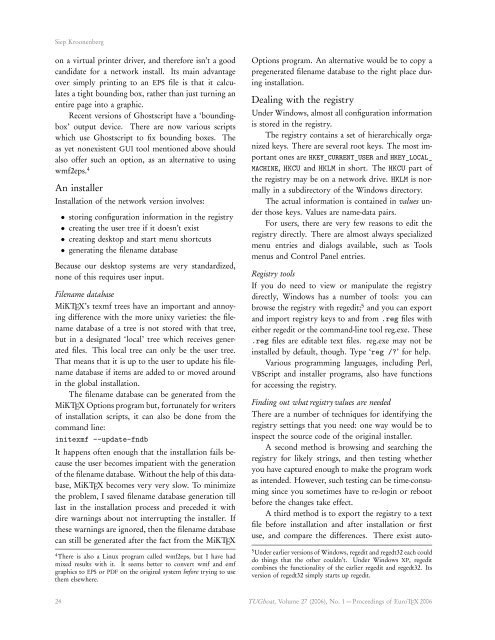The Communications of the TEX Users Group Volume 27 ... - TUG
The Communications of the TEX Users Group Volume 27 ... - TUG
The Communications of the TEX Users Group Volume 27 ... - TUG
You also want an ePaper? Increase the reach of your titles
YUMPU automatically turns print PDFs into web optimized ePapers that Google loves.
Siep Kroonenberg<br />
on a virtual printer driver, and <strong>the</strong>refore isn’t a good<br />
candidate for a network install. Its main advantage<br />
over simply printing to an EPS file is that it calculates<br />
a tight bounding box, ra<strong>the</strong>r than just turning an<br />
entire page into a graphic.<br />
Recent versions <strong>of</strong> Ghostscript have a ‘boundingbox’<br />
output device. <strong>The</strong>re are now various scripts<br />
which use Ghostscript to fix bounding boxes. <strong>The</strong><br />
as yet nonexistent GUI tool mentioned above should<br />
also <strong>of</strong>fer such an option, as an alternative to using<br />
wmf2eps. 4<br />
An installer<br />
Installation <strong>of</strong> <strong>the</strong> network version involves:<br />
• storing configuration information in <strong>the</strong> registry<br />
• creating <strong>the</strong> user tree if it doesn’t exist<br />
• creating desktop and start menu shortcuts<br />
• generating <strong>the</strong> filename database<br />
Because our desktop systems are very standardized,<br />
none <strong>of</strong> this requires user input.<br />
Filename database<br />
MiK<strong>TEX</strong>’s texmf trees have an important and annoying<br />
difference with <strong>the</strong> more unixy varieties: <strong>the</strong> filename<br />
database <strong>of</strong> a tree is not stored with that tree,<br />
but in a designated ‘local’ tree which receives generated<br />
files. This local tree can only be <strong>the</strong> user tree.<br />
That means that it is up to <strong>the</strong> user to update his filename<br />
database if items are added to or moved around<br />
in <strong>the</strong> global installation.<br />
<strong>The</strong> filename database can be generated from <strong>the</strong><br />
MiK<strong>TEX</strong> Options program but, fortunately for writers<br />
<strong>of</strong> installation scripts, it can also be done from <strong>the</strong><br />
command line:<br />
initexmf --update-fndb<br />
It happens <strong>of</strong>ten enough that <strong>the</strong> installation fails because<br />
<strong>the</strong> user becomes impatient with <strong>the</strong> generation<br />
<strong>of</strong> <strong>the</strong> filename database. Without <strong>the</strong> help <strong>of</strong> this database,<br />
MiK<strong>TEX</strong> becomes very very slow. To minimize<br />
<strong>the</strong> problem, I saved filename database generation till<br />
last in <strong>the</strong> installation process and preceded it with<br />
dire warnings about not interrupting <strong>the</strong> installer. If<br />
<strong>the</strong>se warnings are ignored, <strong>the</strong>n <strong>the</strong> filename database<br />
can still be generated after <strong>the</strong> fact from <strong>the</strong> MiK<strong>TEX</strong><br />
4 <strong>The</strong>re is also a Linux program called wmf2eps, but I have had<br />
mixed results with it. It seems better to convert wmf and emf<br />
graphics to EPS or PDF on <strong>the</strong> original system before trying to use<br />
<strong>the</strong>m elsewhere.<br />
Options program. An alternative would be to copy a<br />
pregenerated filename database to <strong>the</strong> right place during<br />
installation.<br />
Dealing with <strong>the</strong> registry<br />
Under Windows, almost all configuration information<br />
is stored in <strong>the</strong> registry.<br />
<strong>The</strong> registry contains a set <strong>of</strong> hierarchically organized<br />
keys. <strong>The</strong>re are several root keys. <strong>The</strong> most important<br />
ones are HKEY_CURRENT_USER and HKEY_LOCAL_<br />
MACHINE, HKCU and HKLM in short. <strong>The</strong> HKCU part <strong>of</strong><br />
<strong>the</strong> registry may be on a network drive. HKLM is normally<br />
in a subdirectory <strong>of</strong> <strong>the</strong> Windows directory.<br />
<strong>The</strong> actual information is contained in values under<br />
those keys. Values are name-data pairs.<br />
For users, <strong>the</strong>re are very few reasons to edit <strong>the</strong><br />
registry directly. <strong>The</strong>re are almost always specialized<br />
menu entries and dialogs available, such as Tools<br />
menus and Control Panel entries.<br />
Registry tools<br />
If you do need to view or manipulate <strong>the</strong> registry<br />
directly, Windows has a number <strong>of</strong> tools: you can<br />
browse <strong>the</strong> registry with regedit; 5 and you can export<br />
and import registry keys to and from .reg files with<br />
ei<strong>the</strong>r regedit or <strong>the</strong> command-line tool reg.exe. <strong>The</strong>se<br />
.reg files are editable text files. reg.exe may not be<br />
installed by default, though. Type ‘reg /?’ for help.<br />
Various programming languages, including Perl,<br />
VBScript and installer programs, also have functions<br />
for accessing <strong>the</strong> registry.<br />
Finding out what registry values are needed<br />
<strong>The</strong>re are a number <strong>of</strong> techniques for identifying <strong>the</strong><br />
registry settings that you need: one way would be to<br />
inspect <strong>the</strong> source code <strong>of</strong> <strong>the</strong> original installer.<br />
A second method is browsing and searching <strong>the</strong><br />
registry for likely strings, and <strong>the</strong>n testing whe<strong>the</strong>r<br />
you have captured enough to make <strong>the</strong> program work<br />
as intended. However, such testing can be time-consuming<br />
since you sometimes have to re-login or reboot<br />
before <strong>the</strong> changes take effect.<br />
A third method is to export <strong>the</strong> registry to a text<br />
file before installation and after installation or first<br />
use, and compare <strong>the</strong> differences. <strong>The</strong>re exist auto-<br />
5 Under earlier versions <strong>of</strong> Windows, regedit and regedt32 each could<br />
do things that <strong>the</strong> o<strong>the</strong>r couldn’t. Under Windows XP, regedit<br />
combines <strong>the</strong> functionality <strong>of</strong> <strong>the</strong> earlier regedit and regedt32. Its<br />
version <strong>of</strong> regedt32 simply starts up regedit.<br />
24 <strong>TUG</strong>boat, <strong>Volume</strong> <strong>27</strong> (2006), No. 1 — Proceedings <strong>of</strong> Euro<strong>TEX</strong> 2006

















